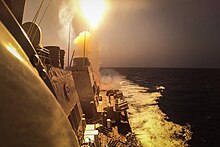Middle Eastern crisis (2023–present)
Ongoing Lebanon Lebanon Iran, Iraq and Syria Yemen and the Red Sea Deaths Related topics The Middle Eastern crisis is a series of interrelated wars, conflicts, and heightened instability in the Middle East that began in 2023 after the 7 October Hamas-led attack on Israel.
Shortly after the Gaza war began, several Iran-backed militias in the Axis of Resistance joined the conflict against Israel.
[30][31] After the truce expired in December, Israeli troops had reached the city of Khan Yunis in central Gaza.
[36] On 16 October 2024, the Israeli military killed the leader of Hamas, Yahya Sinwar, hence achieving a major goal of Israel's invasion of Gaza.
[40] On 15 January 2025, Israel and Hamas agreed to a ceasefire that would halt fighting in the Gaza Strip upon its ratification and lead to the release of 33 Israeli hostages in exchange for Palestinian prisoners.
[58] On 28 August 2024, Israel began an expansive military operation in the West Bank consisting of raids, airstrikes, and the blocking of entry points in Jenin and Tulkarm,[59][60][61] marking its largest offensive in the territory since the Second Intifada.
[47] On 21 January 2025, Israel launched its first major post-ceasefire raid, targeting Jenin, and announced that it intended to maintain a long-term military presence in the city, marking a shift in strategy.
[63] The PA has partial administrative authority in the region,[64][65] and is dominated by Fatah,[66] whose collaborations with the Israeli military for security[64][67] have been criticized by militias including Hamas and PIJ.
[80] On 2 January 2024, Israel conducted an airstrike that in the Dahieh suburb of Beirut that assassinated Hamas deputy leader Saleh al-Arouri.
[93][96] On 1 October 2024, Israel began an invasion of southern Lebanon that it said was to eliminate the threat posed by Hezbollah and allow the 63,000 Israelis still displaced to return to their homes.
[113] In December, the United States created Operation Prosperity Guardian, a multinational naval coalition aimed at combatting attacks in the Red Sea.
[114] The coalition includes the U.S., the United Kingdom, Australia, Bahrain, Canada, France, Italy, the Netherlands, New Zealand, Norway, Seychelles, and Spain.
[116] On 12 January, the U.S. and U.K. began airstrikes in Houthi-controlled Yemen[117] following a United Nations Security Council resolution that condemned the Houthi attacks.
[118][119] The strikes were ordered by U.S. president Joe Biden and U.K. prime minister Rishi Sunak authorized British participation.
[135] Shortly after, Iran conducted strikes in Pakistan targeting Jaish ul-Adl, a Sunni Islamic militant group.
[142] In January, Israel killed an Iranian general of the Islamic Revolutionary Guard Corps (IRGC) Quds Force alongside 12 others.
[143] On 1 April, it bombed the consulate annex of Iran's embassy in Damascus, killing 16, including Mohammad Reza Zahedi, the Quds Force commander in Syria and Lebanon.
[156][157] Led by Hay'at Tahrir al-Sham (HTS) and supported by Turkish-backed rebels, the offensive was the first since the 2020 ceasefire that largely halted major fighting in the Syrian civil war, which began in 2011.
[168] After the fall of the Assad regime, Netanyahu said that the 1974 Israel–Syria border agreement had "collapsed" and ordered the Israeli military to begin an invasion of the buffer zone in Syria along the Golan Heights.
[169] Israel seized Syria's side of Mount Hermon,[170] occupied border villages in Syrian-controlled parts of the Golan Heights,[171] and bombed targets across Damascus and southern Syria in addition to abandoned Syrian Arab Armed Forces (SAAF) weapons stockpiles and airbases.
[40] The GHM does not distinguish between civilians and combatants;[197] the Israeli Institute for National Security Studies says Israel has killed more than 17,000 militants,[198] while Hamas said in April 2024 that it had lost no more than 20 percent, or about 6,000, of its fighters.
[199] An Associated Press analysis of GHM data up to April 2024 found that women and children comprised 54 percent of all identified dead, a statistic often used as a proxy for civilian casualties.
[200][201] In Israel, the 7 October Hamas-led attack resulted in the deaths of 1,195 people, including 816 civilians and 379 members of the security forces.
[216] According to Lebanon's ministry of public health, fourteen journalists have been killed by Israeli attacks while reporting on the conflict.
[217][110] Five U.S. soldiers died in January 2024: two were lost at sea on a mission to seize Iranian weapons[221] and three were killed in an IRI attack in Jordan that injured 47 others.
[223] Later in 2024, Saudi Crown Prince Mohamed bin Salman said that any Saudi–Israeli normalization agreement would require Palestinian statehood as part of a two-state solution.
[226] South Africa requested that the ICJ order an immediate halt to Israel's military operations in Gaza among other provisional measures of protection.
[228] On 26 January 2024, the ICJ said in a preliminary ruling that South Africa's allegations are "plausible" and that Israel must "take all measures within its power" to prevent genocide in Gaza.
[231][232] On 25 March, the UNSC passed Resolution 2728, which called for a ceasefire during the month of Ramadan, the "immediate and unconditional" release of all hostages, and the allowance of humanitarian aid into Gaza.




